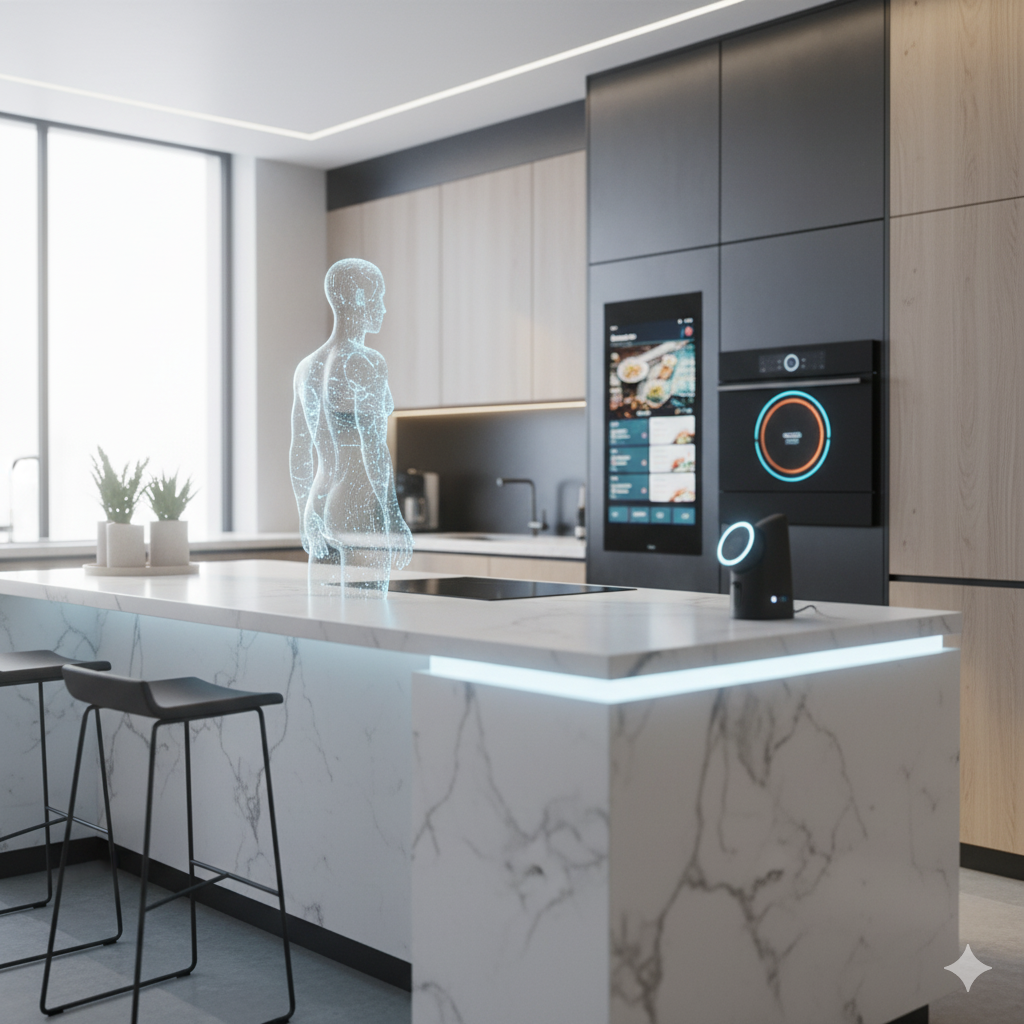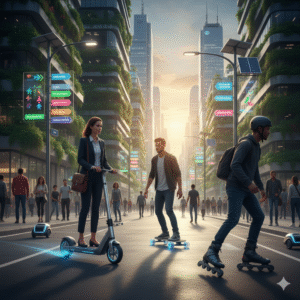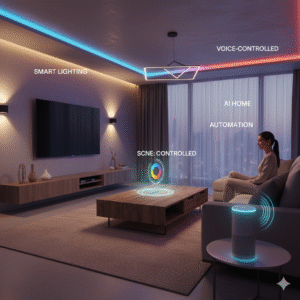Electric Vehicles & Personal Mobility Tech — electric skates, scooters, boards
1. Introduction — The New Age of Urban Motion
Cities everywhere are transforming. Beneath the glass towers and bike lanes, a quieter revolution hums on lithium batteries: personal electric vehicles (PEVs). From foldable scooters gliding between cafés to futuristic e-skates carving downtown paths, mobility is no longer about horsepower—it’s about smart power.
The global move toward sustainable, efficient, and compact transportation is fueled by rapid advances in battery chemistry, motor efficiency, and Internet-of-Things (IoT) connectivity. As congestion worsens and fuel prices rise, electric scooters, boards, and skates are becoming symbols of urban independence—offering clean, fun, and cost-effective ways to move.
This isn’t a fad. By 2025, analysts estimate the micro-mobility market will exceed $250 billion, with electric scooters and skateboards leading adoption. Consumers are choosing devices that blend performance, portability, and personality. Welcome to the age of personal mobility tech—where sustainability meets adrenaline.
2. How Micro-Mobility Is Redefining Urban Transport
2.1 The Rise of Compact Commuting
Traditional transportation models—cars, taxis, and buses—are giving way to compact, last-mile solutions. A 5-km commute that once required a car can now be conquered in minutes with an electric scooter.
Cities such as Paris, San Francisco, and Singapore have witnessed a surge in micro-mobility adoption. Dockless rental fleets like Lime and Bird began the trend, but personal ownership is now dominant, driven by falling hardware costs and rising eco-awareness.
2.2 Reducing Congestion & Emissions
Each electric ride represents one less internal-combustion engine. Studies show that when 10% of car commuters switch to micro-mobility, overall traffic congestion can drop by 20%. Moreover, small lithium-ion batteries emit zero tailpipe emissions and consume a fraction of grid energy compared with gasoline vehicles.
2.3 Economic & Social Impact
Micro-mobility democratizes movement. Students, delivery workers, and digital nomads gain freedom without car payments or parking fees. The result is a leaner, greener economy, where people and parcels move seamlessly across cities.
3. Types of Personal EVs — Scooters, Skateboards & Beyond
The umbrella of personal electric vehicles covers an exciting spectrum of devices:
3.1 Electric Scooters
Compact, upright, and easy to fold, e-scooters dominate the market. They’re favored for their balance between speed (up to 40 km/h) and stability. High-end models feature dual motors, hydraulic brakes, and smart dashboards.
3.2 Electric Skateboards & Longboards
Popular among youth and tech enthusiasts, e-boards use hub or belt motors for controlled acceleration and braking. Modern versions integrate regenerative braking and smart remote throttles. Some, like Boosted Rev and Meepo Hurricane, deliver speeds over 45 km/h with hill-climb torque once reserved for motorcycles.
3.3 Hoverboards & Self-Balancing Tech
Hoverboards bring playful mobility into malls, campuses, and warehouses. Gyroscopic balance sensors keep riders stable, while LED lighting and Bluetooth speakers add style. Newer self-balancing unicycles—like InMotion V13 Challenger—push boundaries of range and speed.
3.4 Electric Skates & Wearable Drive Systems
The next frontier is electric skates—lightweight, modular shoes with wheel motors. Products like Atmos Gear transform ordinary sneakers into 25 km/h skates with smartphone control. They represent the essence of personal tech freedom: strap-on, charge, go.
3.5 Folding Bikes & Hybrid EVs
While scooters rule the sidewalks, folding e-bikes serve commuters needing higher range (40–100 km). Hybrid boards combine skateboard agility with scooter handles, expanding ergonomic diversity.
Together, these devices create a micro-mobility ecosystem addressing every lifestyle—from adrenaline-seekers to office commuters.
4. Inside the Tech — Batteries, Motors & Smart Controllers
4.1 Battery Chemistry & Energy Density
The heart of every personal EV is its battery pack. Most models employ lithium-ion or lithium-polymer cells (18650 or 21700 formats). Manufacturers now focus on:
- Higher energy density: 300 Wh/kg batteries mean smaller packs with longer range.
- Fast charging: GaN chargers deliver 80% charge in under 45 minutes.
- Thermal management: Smart BMS (Battery Management Systems) regulate heat & cell balance.
4.2 Motor Innovation
Brushless DC motors (BLDC) dominate the sector for efficiency > 90%. Hub motors integrate directly into wheels, eliminating belts and gears. Torque sensors and AI-based traction control provide smoother acceleration even on slippery surfaces.
4.3 Controllers & Smart Firmware
Microcontrollers translate throttle inputs into power curves. Advanced models feature riding modes, cruise control, and mobile diagnostics. Firmware updates over the air (OTA) enable continuous performance tuning—an industry first for mobility hardware.
4.4 Connectivity
BLE 5.0 and Wi-Fi modules let users pair vehicles with apps to track range, lock/unlock, or share rides. Integration with Apple Find My and Google Home adds security and convenience.
5. Range, Speed & Charging — Breaking Performance Barriers
Range anxiety once plagued small EVs. That’s changing rapidly.
5.1 The Range Revolution
2025 models boast:
- Scooters: 40–90 km per charge.
- Skateboards: 25–60 km.
- Electric Skates: 15–30 km with pocket-size packs.
Regenerative braking recovers 5–10% of energy while descending hills or slowing down.
5.2 Speed & Power Delivery
Top tiers hit 60 km/h with dual 1 000 W motors. AI-tuned ESCs (Electronic Speed Controllers) adjust output based on rider weight, terrain, and temperature. New “smart torque curves” make acceleration linear and safe.
5.3 Charging Infrastructure
Portable chargers fit into backpacks. Public charging pods are emerging at cafés and coworking spaces. Some cities experiment with inductive wireless charging pads for fleet scooters. A 15-minute coffee break can restore 30 km of range.
6. Design Trends 2025 — Lightweight, Foldable & Futuristic
Industrial design is a key differentiator. Consumers want devices that look as good as they perform.
6.1 Aesthetics Meet Aerodynamics
Carbon-fiber frames and CNC-milled aluminum keep weights under 12 kg for scooters and 8 kg for boards. Matte finishes, RGB edge lighting, and hidden cables enhance minimalism.
6.2 Ergonomics & Comfort
Adjustable stems, shock-absorbing decks, and air-filled tires improve ride quality. Handlebar design now incorporates touch displays showing speed, battery, and navigation.
6.3 Foldability & Portability
Commuters demand easy storage. Quick-fold hinges and magnet locks let riders board metros within seconds. Electric skates fit in a backpack, redefining the concept of last-mile mobility.
6.4 Customization Culture
Color wraps, modular batteries, and swappable wheels allow personalization. Brands embrace this trend with community design apps and NFT-linked skins for digital collectibility.
7. Safety & Regulation Across Cities
As personal EVs multiply, regulators race to keep up. Cities differ in speed limits (typically 20–30 km/h for public paths) and helmet rules. Still, a global push for standardized safety codes is emerging.
7.1 Built-In Safety Tech
- Dual brake systems: electronic and mechanical for redundancy.
- Auto headlights & brake lights for visibility.
- Fall detection sensors that trigger emergency alerts via apps.
7.2 Protective Gear & Education
Brands promote safe riding through training events and AR tutorials. Helmet manufacturers introduce integrated HUDs (Heads-Up Displays) showing speed and GPS directions.
7.3 Legal Adoption Trends
Countries like Germany and Japan have legalized specific e-mobility categories with insurance frameworks. The U.S. and U.K. are expanding pilot zones to evaluate traffic impact and environmental benefits.
Regulation may seem restrictive, but it’s paving the way for mass adoption with safety and accountability.
8. Sustainability & Energy Efficiency
The eco appeal of personal EVs is undeniable, but sustainability goes beyond zero emissions.
8.1 Lower Energy Footprint
A typical scooter uses 0.015 kWh per km—roughly 1% of what a gas car consumes. Charging from solar rooftops turns commutes completely carbon-neutral.
8.2 Durability & Repairability
Manufacturers shift to modular designs with replaceable motors and batteries, extending lifespans and reducing e-waste. Open-source repair guides empower users to maintain their vehicles independently.
8.3 Recycling Initiatives
Battery recycling partnerships with companies like Redwood Materials and Li-Cycle are closing the loop. Recovered nickel and lithium feed directly into new cells, creating a circular energy economy.
8.4 Smart Energy Use
AI-powered apps optimize charging times based on grid demand, reducing peak-hour load. Some e-boards even feed surplus energy back to home batteries via V2H (Vehicle-to-Home) protocols.
Sustainability is no longer a bonus —it’s a core purchase driver for modern mobility enthusiasts.
9. Connectivity & App Integration — Smarter Rides for Smarter Cities
Today’s electric scooters and boards aren’t just machines; they’re connected devices that form part of the larger IoT ecosystem. Through Bluetooth, Wi-Fi, and cellular connectivity, riders can now control, track, and optimize their vehicles right from a smartphone.
9.1 Mobile Dashboards
Most e-scooters and skateboards now come with companion apps offering:
- Real-time diagnostics: Motor temperature, tire pressure, and battery health.
- Trip history & route tracking: Integrated with Google Maps or Apple Maps.
- Lock/unlock functions: Digital key access through biometrics or NFC.
- Geo-fencing: Limit speed automatically in pedestrian zones.
9.2 Over-the-Air (OTA) Updates
Like smartphones, many e-mobility devices receive firmware updates wirelessly. Manufacturers push bug fixes, performance boosts, and even new riding modes directly to the user — extending product longevity and safety.
9.3 Ecosystem Integration
Voice assistants such as Alexa, Siri, and Google Assistant can check battery levels or activate anti-theft alarms. Integration with Matter and Apple Find My makes personal EVs easier to locate and manage.
This connected future ensures that your scooter or board is not just transport — it’s an intelligent companion tuned to your habits, preferences, and routes.
10. Emerging Brands & Market Leaders in 2025
The personal mobility tech space has exploded with innovation. Established companies refine the classics, while startups bring creativity and speed to the market.
10.1 Leading Electric Scooter Brands
- Xiaomi & Segway-Ninebot: Dominating the mass market with balance between price and reliability.
- Unagi & Apollo: Known for premium aesthetics and high performance.
- Okai & TurboAnt: Rising brands offering advanced connectivity and AI-assisted diagnostics.
10.2 Electric Skateboard & Longboard Pioneers
- Boosted (legacy influence): Set early design standards for safety and ergonomics.
- Meepo, Exway, and Evolve: Competing fiercely with high-torque, modular boards.
- Backfire: Specializing in long-range commuters with ergonomic decks.
10.3 Electric Skates & Niche Mobility
- Atmos Gear: Introduced the first smart electric inline skates.
- Onewheel: Continues to innovate with self-balancing single-wheel boards.
- InMotion & Begode: Pushing limits in unicycles and self-balancing performance rides.
10.4 Market Dynamics
- Asia leads production (China, Japan, Korea).
- North America and Europe lead in adoption and regulation.
- Middle Eastern and Latin American cities are rapidly developing EV-friendly infrastructure.
By 2030, analysts predict over 400 million personal electric vehicles in circulation globally — redefining how cities function.
11. Comparing Cost of Ownership vs Traditional Transport
One of the biggest advantages of personal EVs is cost efficiency.
11.1 Upfront vs Long-Term Costs
- E-Scooter: $400–$1,500 initial cost.
- E-Skateboard: $600–$2,000.
- Electric Skates: Around $500–$800.
In contrast, even a small car demands thousands in fuel, insurance, and maintenance yearly.
11.2 Operating Costs
Charging an e-scooter costs less than $0.10 per ride. Maintenance — mainly tires, bearings, and brakes — remains minimal.
11.3 Ownership Advantages
- Zero parking fees
- Low depreciation due to modular parts
- Eligible for EV incentives in many regions
- No license or registration (in most cities)
Over a 3-year span, personal EV owners can save between $2,000–$6,000 compared to public transit or fuel-based commuting.
In short, personal EVs aren’t just eco-friendly—they’re economically unbeatable.
12. Personal Mobility for Commuters vs Adventurers
Not all electric mobility users are the same. There’s a spectrum—from city commuters seeking efficiency to adventurers craving thrill.
12.1 Urban Commuters
City professionals love foldable scooters and compact longboards for their lightweight form and reliability. Their focus: range, portability, and safety.
12.2 Recreational Riders
Enthusiasts push speed and power. They favor off-road boards with all-terrain wheels, suspension systems, and 50 km/h capabilities.
12.3 Delivery & Gig Economy
Food and parcel couriers increasingly adopt e-scooters and bikes for cost efficiency. In dense areas like New York or Bangkok, delivery times are cut by 40%.
12.4 Accessibility & Inclusivity
Electric mobility also opens doors for elderly or mobility-impaired users through stable three-wheeled scooters or self-balancing tech.
Personal EVs thus cater to diverse lifestyles — from efficient urban transport to extreme recreation — symbolizing freedom for every rider.
13. Battery Recycling & Eco Innovation
Sustainability doesn’t end at zero emissions. The battery life cycle is the next environmental challenge, and manufacturers are tackling it head-on.
13.1 Recycling Ecosystem
Recycling programs now recover up to 95% of lithium, cobalt, and nickel. Companies like Redwood Materials, Li-Cycle, and Umicore collaborate with scooter manufacturers to close the materials loop.
13.2 Second-Life Applications
Used batteries find new purpose in energy storage units for solar homes or EV charging stations.
13.3 Eco Materials
Frames are being made from recycled aluminum and plant-based composites. Tire manufacturers are experimenting with natural rubber blends that reduce microplastic emissions.
13.4 Carbon-Neutral Production
Brands like Ecovolt Mobility and Unagi now commit to carbon-offset programs, ensuring every unit shipped has a net-zero footprint.
The end result: electric mobility that’s sustainable throughout its entire life cycle.
14. Government Incentives & Urban Infrastructure
Policy is playing a huge role in the rise of personal EVs.
14.1 Global Incentives
- European Union: Cities like Paris and Milan offer €300–€500 rebates for electric scooters and bikes.
- United States: Federal and state-level credits apply under clean energy initiatives.
- Asia-Pacific: Singapore and Japan subsidize micro-mobility sharing systems.
14.2 Smart Infrastructure
Governments are investing in:
- Dedicated micro-mobility lanes
- Charging hubs in public spaces
- Digital traffic monitoring for AI-based fleet control
14.3 City Partnerships
Tech-forward cities like Dubai, Seoul, and Stockholm collaborate with scooter startups to integrate real-time data into smart traffic systems.
With continued investment, urban environments will evolve to be micro-mobility-first, reducing cars and prioritizing lightweight electric transport.
15. The Future of Personal Mobility — AI and Autonomous Assist
The next evolution of personal EVs lies in autonomy and artificial intelligence.
15.1 AI-Enhanced Performance
AI algorithms already learn rider habits, adjusting torque, speed, and braking for comfort and safety. Predictive maintenance alerts users before a failure occurs.
15.2 Semi-Autonomous Navigation
Future scooters may feature LiDAR sensors and computer vision for obstacle detection and self-parking. Autonomous boards could follow users or deliver items.
15.3 Integration with Smart Cities
As cities install V2X (Vehicle-to-Everything) communication networks, scooters will interact with traffic lights and crossings to prevent accidents.
15.4 Biometrics & Wearable Sync
Devices will soon sync with wearables like smartwatches to track fatigue, heart rate, and safety metrics. If the rider feels unwell, the vehicle can automatically stop or alert help.
AI will not just improve riding — it will make mobility intuitive, anticipatory, and personalized.
16. Conclusion — Freedom on Two, Four, or One Wheel
From humble scooters to futuristic electric skates, personal mobility tech has redefined what it means to move freely. In just a few years, electric vehicles have gone from niche gadgets to essential tools of modern living.
They save time, reduce emissions, and empower riders with independence and style. Whether you’re zipping through traffic on a foldable e-scooter or carving a boardwalk on an e-longboard, one truth remains: mobility is becoming personal, intelligent, and sustainable.
As AI, IoT, and sustainable engineering continue to advance, the next generation of devices will be lighter, smarter, and even self-aware — redefining not just how we travel, but how we connect with the world around us.
The electric mobility revolution isn’t coming — it’s already here, quietly transforming sidewalks, cities, and lifestyles one silent motor at a time.
Share this content:













Post Comment